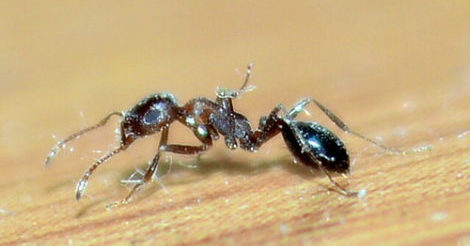
 )
)This reflection on the themes of Ant-Man and the Wasp tries to avoid spoilers, but as always feel free to wait until you’ve seen the movie if you want to know nothing about it when watching.
I know I’ve already covered several movies recently, but I hope you’ll indulge me one more time this summer for the film I’ve been most looking forward to this year: Ant-Man and the Wasp. I love the dynamic and inventive visuals of size-changing in action. I’m intrigued by the Quantum Realm. Most of all, the idea of a superhero who talks to ants brings me a lot of joy.
Aquaman is the punchline of many jokes because he talks to fish, but he has no choice; he was born that way. Henry Pym talks to ants because he wanted to, so he built a machine that makes it possible. I think it’s great to see a depiction of scientific curiosity, of learning more about the world simply because it’s there and somebody ought to know what’s going on. Granted, their relationship is not exactly one of peers; the film version of Pym is especially transactional with respect to his ant assistants. But the films could have jettisoned such a seemingly goofy aspect of the character altogether in favor of a more “grounded” or “realistic” interpretation, and instead they embrace it. And so we have a hero who saw the vast gulf of experience and communication between himself and other living creatures and decided to build a bridge.
There are obviously a variety of barriers to relationships betwixt man and ant, with one of the most apparent being the differences in scale. In between jokes and set pieces, Ant-Man and the Wasp expresses some interest in how scale influences our perceptions. There’s a riff on the common experience of revisiting places from our childhood and noticing how everything seems smaller. There’s the attention to detail in showing how the speed of movement is related to scale. And most notable of all, there is the Quantum Realm.

Now, to be clear, most of the “quantum” discussion in the film falls under the heading of “woo” rather than science–a fact I suspect the filmmakers know, having included a joke about throwing the word “quantum” in front of everything. Still, there is a kernel of truth to the Quantum Realm idea, namely that the way the world works changes in some fundamental ways as you go to smaller and smaller scales. The visuals attempt to convey this by giving way to abstract geometric figures, which is fairly apt since our understanding of what happens on a subatomic scale is guided at least as much by the mathematics of quantum mechanics as by observations. And while entanglement may not work as depicted, I think the emphasis the movie places on the mental challenge of coping with counterintuitive behavior at subatomic scales is warranted.
Exploring the microscopic and subatomic world is just one direction Henry Pym’s scientific curiosity takes him in the comics. In Avengers: A.I., he introduces the idea of an infinite game, one whose objective is not to win but to simply keep playing. As the story progresses, we travel to the distant future to see one possible extrapolation of human and technological development. Coping with the magnitude of change on long time scales can be just as mind-bending as dealing with tiny spatial scales. It’s something I’ve thought about periodically in relation to the Biblical ideas of a new creation and eternal life. What does it take mentally to live forever? How does one prepare?
I know there are different understandings of what is meant by eternal life, not all of which entail an unending succession of linearly unfolding time. Still, I think that popular picture is interesting to contemplate. And while we can’t be certain of everything such an existence might involve, we can be pretty sure it will include plenty of time to spend with plenty of different people. That’s also something we can easily prepare for, by building some communication bridges now. Fortunately, learning to talk to other people isn’t nearly as tricky as learning to talk to ants.
We’re a couple weeks away from the ASA meeting at Gordon College. Don’t forget about the scholarships and discounts available to students. And as an added bonus, the student group bringing the most attendees will win three (3) copies of Faith across the Multiverse. Those may come in handy for a book group this fall; stay tuned.
Obviously the Francis Collins talk will be a big draw, but don’t sleep on other programming highlights including S. Joshua Swamidass’ Friday workshop on Adam & Eve, the ESN track for students and early career academics on Saturday, posters and talks by folks like Julie Reynolds and Ted Davis, and more. If you have a talk or poster, please mention it in the comments below and I’ll flag it up in a future post. I can’t wait to see everyone there!
Andy has worn many hats in his life. He knows this is a dreadfully clichéd notion, but since it is also literally true he uses it anyway. Among his current metaphorical hats: husband of one wife, father of two teenagers, reader of science fiction and science fact, enthusiast of contemporary symphonic music, and chief science officer. Previous metaphorical hats include: comp bio postdoc, molecular biology grad student, InterVarsity chapter president (that one came with a literal hat), music store clerk, house painter, and mosquito trapper. Among his more unique literal hats: British bobby, captain’s hats (of varying levels of authenticity) of several specific vessels, a deerstalker from 221B Baker St, and a railroad engineer’s cap. His monthly Science in Review is drawn from his weekly Science Corner posts — Wednesdays, 8am (Eastern) on the Emerging Scholars Network Blog. His book Faith across the Multiverse is available from Hendrickson.

Leave a Reply